Jenn-Air JES8860, JES8750, JES8850 User Manual

JENN-AIR® ELECTRIC SLIDE-IN RANGE CUISINIÈRE ENCASTRABLE ÉLECTRIQUE JENN-AIR®
Use & Care Guide
For questions about features, operation/performance, parts, accessories, or service in the U.S.A., call:
1-800-JENNAIR (1-800-536-6247) or visit our website at www.jennair.com.
In Canada, call: 1-800-807-6777, or visit our website at www.jennair.ca.
Guide d’utilisation et d’entretien
Au Canada, pour assistance, installation ou service, composez le 1-800-807-6777 ou visitez notre site web à www.jennair.ca.
Table of Contents/Table des matières ................... |
2 |
JES8750, JES8860, JES8850
W10235523A

TABLE OF CONTENTS |
|
RANGE SAFETY ............................................................................. |
3 |
The Anti-Tip Bracket .................................................................... |
3 |
COOKTOP USE .............................................................................. |
5 |
Cooktop Controls......................................................................... |
5 |
Dual and Triple Elements ............................................................. |
6 |
Custom Control Element.............................................................. |
6 |
Cook and Warm Element............................................................. |
6 |
Warm Zone................................................................................... |
7 |
Ceramic Glass.............................................................................. |
7 |
Home Canning ............................................................................. |
7 |
Cookware ..................................................................................... |
8 |
ELECTRONIC OVEN CONTROLS................................................. |
8 |
Electronic Control Pads ............................................................... |
9 |
Oven Display ................................................................................ |
9 |
Quickset Pads .............................................................................. |
9 |
Cancel .......................................................................................... |
9 |
Clock ............................................................................................ |
9 |
Timers......................................................................................... |
10 |
Locking the Oven Control and Oven Door ................................ |
10 |
Oven Light .................................................................................. |
10 |
Setup .......................................................................................... |
10 |
OVEN USE..................................................................................... |
13 |
Aluminum Foil............................................................................. |
13 |
Positioning Racks and Bakeware .............................................. |
13 |
Bakeware.................................................................................... |
14 |
Meat Thermometer..................................................................... |
14 |
Oven Vent................................................................................... |
14 |
Bake............................................................................................ |
14 |
Broil ............................................................................................ |
15 |
Convection Cooking................................................................... |
15 |
Convect Bake............................................................................. |
16 |
Convect Roast............................................................................ |
16 |
Convect Pastry........................................................................... |
17 |
Rapid Preheat............................................................................. |
17 |
More Options ............................................................................. |
17 |
Warming Drawer ........................................................................ |
18 |
Meat Probe................................................................................. |
19 |
Drying ......................................................................................... |
20 |
Thaw and Serve ......................................................................... |
21 |
Favorites..................................................................................... |
22 |
RANGE CARE ............................................................................... |
23 |
Self-Cleaning Cycle.................................................................... |
23 |
General Cleaning........................................................................ |
24 |
Oven Lights ................................................................................ |
25 |
Storage Drawer .......................................................................... |
25 |
Warming Drawer ........................................................................ |
26 |
Oven Door .................................................................................. |
26 |
TROUBLESHOOTING .................................................................. |
26 |
ASSISTANCE OR SERVICE......................................................... |
28 |
In the U.S.A. ............................................................................... |
28 |
Accessories List ......................................................................... |
28 |
In Canada ................................................................................... |
28 |
WARRANTY .................................................................................. |
29 |
TABLE DES MATIÈRES |
|
SÉCURITÉ DE LA CUISINIÈRE ................................................... |
31 |
La bride antibasculement........................................................... |
31 |
UTILISATION DE LA TABLE DE CUISSON................................ |
34 |
Commandes de la table de cuisson .......................................... |
34 |
Éléments double/triple ............................................................... |
35 |
Élément de contrôle personnalisé.............................................. |
35 |
Élément de cuisson et de maintien au chaud............................ |
36 |
Zone de maintien au chaud ....................................................... |
36 |
Vitrocéramique ........................................................................... |
36 |
Préparation de conserves à la maison....................................... |
37 |
Ustensiles de cuisson ................................................................ |
37 |
COMMANDES ÉLECTRONIQUES DU FOUR ............................ |
38 |
Touches de commande électroniques ...................................... |
38 |
Afficheur du four......................................................................... |
38 |
Touches de réglage rapide ........................................................ |
38 |
Cancel (annulation)..................................................................... |
39 |
Horloge ....................................................................................... |
39 |
Minuteries ................................................................................... |
39 |
Verrouillage du tableau de commande du four et |
|
de la porte du four...................................................................... |
40 |
Lampe du four ............................................................................ |
40 |
Réglage....................................................................................... |
40 |
UTILISATION DU FOUR............................................................... |
43 |
Papier d’aluminium..................................................................... |
43 |
Positionnement des grilles et des ustensiles de cuisson .......... |
43 |
Ustensiles de cuisson ................................................................ |
44 |
Thermomètre à viande ............................................................... |
44 |
Évent du four .............................................................................. |
44 |
Cuisson au four .......................................................................... |
44 |
Cuisson au gril............................................................................ |
45 |
Cuisson par convection ............................................................. |
46 |
Cuisson au four par convection ................................................. |
46 |
Rôtissage par convection .......................................................... |
46 |
Cuisson de pâtisseries par convection...................................... |
47 |
Préchauffage rapide ................................................................... |
47 |
Plus d’options............................................................................. |
47 |
Tiroir-réchaud ............................................................................. |
49 |
Sonde thermométrique .............................................................. |
49 |
Séchage...................................................................................... |
50 |
Décongeler et servir ................................................................... |
52 |
Recettes favorites....................................................................... |
53 |
ENTRETIEN DE LA CUISINIÈRE................................................. |
55 |
Programme d'autonettoyage ..................................................... |
55 |
Nettoyage général ...................................................................... |
56 |
Lampes du four .......................................................................... |
57 |
Tiroir de remisage....................................................................... |
57 |
Tiroir-réchaud ............................................................................. |
58 |
Porte du four............................................................................... |
58 |
DÉPANNAGE................................................................................. |
59 |
ASSISTANCE OU SERVICE......................................................... |
61 |
Liste d'accessoires..................................................................... |
61 |
GARANTIE..................................................................................... |
62 |
2
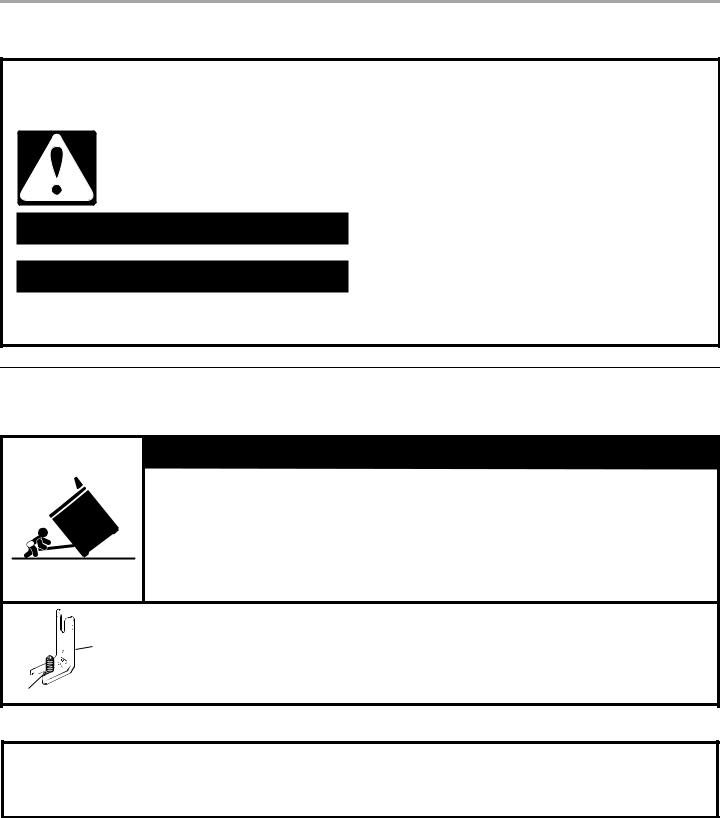
RANGE SAFETY
Your safety and the safety of others are very important.
We have provided many important safety messages in this manual and on your appliance. Always read and obey all safety messages.
This is the safety alert symbol.
This symbol alerts you to potential hazards that can kill or hurt you and others.
All safety messages will follow the safety alert symbol and either the word “DANGER” or “WARNING.” These words mean:
 DANGER
DANGER
 WARNING
WARNING
You can be killed or seriously injured if you don't immediately follow instructions.
You can be killed or seriously injured if you don't follow instructions.
All safety messages will tell you what the potential hazard is, tell you how to reduce the chance of injury, and tell you what can happen if the instructions are not followed.
The Anti-Tip Bracket
The range will not tip during normal use. However, the range can tip if you apply too much force or weight to the open door without having the anti-tip bracket fastened down properly.
 WARNING
WARNING
Tip Over Hazard
A child or adult can tip the range and be killed.
Connect anti-tip bracket to rear range foot.
Reconnect the anti-tip bracket, if the range is moved.
See the installation instructions for details.
Failure to follow these instructions can result in death or serious burns to children and adults.
Anti-Tip
Bracket
Making sure the anti-tip bracket is installed:
•Slide range forward.
•Look for the anti-tip bracket securely attached to floor or wall.
•Slide range back so rear range foot is under anti-tip bracket.
Range Foot
State of California Proposition 65 Warnings:
WARNING: This product contains a chemical known to the State of California to cause cancer.
WARNING: This product contains a chemical known to the State of California to cause birth defects or other reproductive harm.
3

IMPORTANT SAFETY INSTRUCTIONS
WARNING: To reduce the risk of fire, electrical shock, injury to persons, or damage when using the range, follow basic precautions, including the following:
■ WARNING: TO REDUCE THE RISK OF TIPPING OF THE RANGE, THE RANGE MUST BE SECURED BY PROPERLY INSTALLED ANTI-TIP DEVICES. TO CHECK IF THE DEVICES ARE INSTALLED PROPERLY, SLIDE RANGE FORWARD, LOOK FOR ANTI-TIP BRACKET SECURELY ATTACHED TO FLOOR OR WALL, AND SLIDE RANGE BACK SO REAR RANGE FOOT IS UNDER ANTI-TIP BRACKET.
■ CAUTION: Do not store items of interest to children in cabinets above a range or on the backguard of a range – children climbing on the range to reach items could be seriously injured.
■Proper Installation – Be sure the range is properly installed and grounded by a qualified technician.
■Never Use the Range for Warming or Heating the Room.
■Do Not Leave Children Alone – Children should not be left alone or unattended in area where the range is in use. They should never be allowed to sit or stand on any part of the range.
■Wear Proper Apparel – Loose-fitting or hanging garments should never be worn while using the range.
■User Servicing – Do not repair or replace any part of the range unless specifically recommended in the manual. All other servicing should be referred to a qualified technician.
■Storage in or on the Range – Flammable materials should not be stored in an oven or near surface units.
■Do Not Use Water on Grease Fires – Smother fire or flame or use dry chemical or foam-type extinguisher.
■Use Only Dry Potholders – Moist or damp potholders on hot surfaces may result in burns from steam. Do not let potholder touch hot heating elements. Do not use a towel or other bulky cloth.
■DO NOT TOUCH SURFACE UNITS OR AREAS NEAR UNITS – Surface units may be hot even though they are dark in color. Areas near surface units may become hot enough to cause burns. During and after use, do not touch, or let clothing or other flammable materials contact surface units or areas near units until they have had sufficient time to cool. Among those areas are the cooktop and surfaces facing the cooktop.
■Use Proper Pan Size – The range is equipped with one or more surface units of different size. Select utensils having flat bottoms large enough to cover the surface unit heating element. The use of undersized utensils will expose a portion of the heating element to direct contact and may result in ignition of clothing. Proper relationship of utensil to burner will also improve efficiency.
■Never Leave Surface Units Unattended at High Heat Settings – Boilover causes smoking and greasy spillovers that may ignite.
■Make Sure Reflector Pans or Drip Bowls Are in Place – Absence of these pans or bowls during cooking may subject wiring or components underneath to damage.
■Protective Liners – Do not use aluminum foil to line surface unit drip bowls or oven bottoms, except as suggested in the manual. Improper installation of these liners may result in a risk of electric shock, or fire.
■Glazed Cooking Utensils – Only certain types of glass, glass/ceramic, ceramic, earthenware, or other glazed utensils are suitable for range-top service without breaking due to the sudden change in temperature.
■Utensil Handles Should Be Turned Inward and Not Extend Over Adjacent Surface Units – To reduce the risk of burns, ignition of flammable materials, and spillage due to unintentional contact with the utensil, the handle of a utensil should be positioned so that it is turned inward, and does not extend over adjacent surface units.
■Do Not Soak Removable Heating Elements – Heating elements should never be immersed in water.
■Do Not Cook on Broken Cooktop – If cooktop should break, cleaning solutions and spillovers may penetrate the broken cooktop and create a risk of electric shock. Contact a qualified technician immediately.
■Clean Cooktop With Caution – If a wet sponge or cloth is used to wipe spills on a hot cooking area, be careful to avoid steam burn. Some cleaners can produce noxious fumes if applied to a hot surface.
■Use Care When Opening Door – Let hot air or steam escape before removing or replacing food.
■Do Not Heat Unopened Food Containers – Build-up of pressure may cause container to burst and result in injury.
■Keep Oven Vent Ducts Unobstructed.
■Placement of Oven Racks – Always place oven racks in desired location while oven is cool. If rack must be moved while oven is hot, do not let potholder contact hot heating element in oven.
■DO NOT TOUCH HEATING ELEMENTS OR INTERIOR SURFACES OF OVEN – Heating elements may be hot even though they are dark in color. Interior surfaces of an oven become hot enough to cause burns. During and after use, do not touch, or let clothing or other flammable materials contact heating elements or interior surfaces of oven until they have had sufficient time to cool. Other surfaces of the appliance may become hot enough to cause burns – among these surfaces are oven vent openings and surfaces near these openings, oven doors, and windows of oven doors.
For self-cleaning ranges –
■Do Not Clean Door Gasket – The door gasket is essential for a good seal. Care should be taken not to rub, damage, or move the gasket.
■Do Not Use Oven Cleaners – No commercial oven cleaner or oven liner protective coating of any kind should be used in or around any part of the oven.
■Clean Only Parts Listed in Manual.
■Before Self-Cleaning the Oven – Remove broiler pan and other utensils.
For units with ventilating hood –
■Clean Ventilating Hoods Frequently – Grease should not be allowed to accumulate on hood or filter.
■When flambeing foods under the hood, turn the fan on.
SAVE THESE INSTRUCTIONS
4
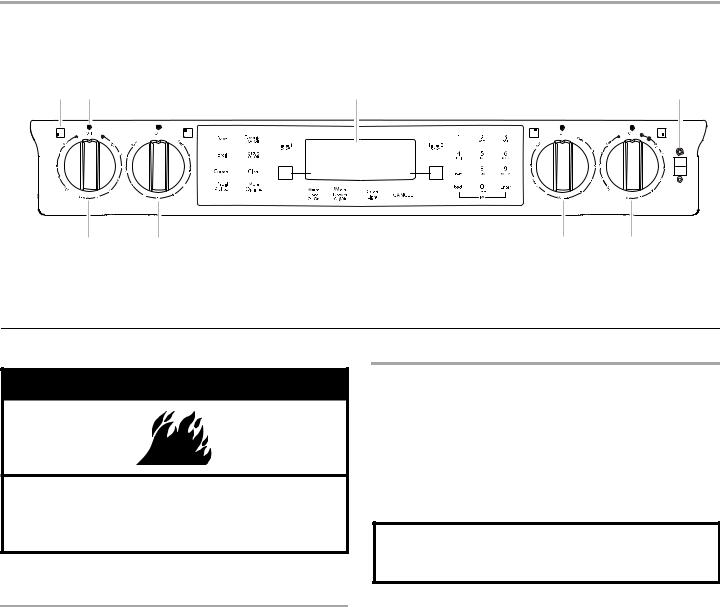
COOKTOP USE
This manual covers several different models. The range you have purchased may have some or all of the items listed. The locations and appearances of the features shown here may not match those of your model.
A B C D
H |
G |
F |
E |
|
A. Surface cooking area locator |
E. Right front control knob |
|
|
B. Cooktop on indicator light |
F. Right rear control knob |
|
|
C. Electronic oven control |
G. Left rear control knob |
|
|
D. Dual/triple element rocker switch |
H. Left front control knob |
|
Cooktop Controls
 WARNING
WARNING
Fire Hazard
Turn off all controls when done cooking.
Failure to do so can result in death or fire.
The cooktop controls can be set to anywhere between HIGH and LOW. Push in and turn to the desired heat setting. Use the following chart as a guide when setting heat levels.
SETTING |
RECOMMENDED USE |
|
|
|
|
Medium Low |
■ Stew or steam food. |
|
1 - 4 |
■ |
Simmer |
|
|
|
LOW |
■ |
Keep foods warm. |
|
■ Melt chocolate or butter. |
|
|
|
|
Warm Zone |
■ Keep cooked foods warm. |
|
|
|
|
REMEMBER: When range is in use or (on some models) during the Self-Cleaning cycle, the entire cooktop area may become hot.
SETTING |
RECOMMENDED USE |
|
|
|
|
Double and Triple |
■ |
Large diameter cookware. |
Elements |
■ |
Large quantities of food. |
|
||
|
■ |
Home canning. |
|
|
|
HIGH |
■ |
Bring liquid to a boil. |
|
|
|
Medium High |
■ |
Hold a rapid boil. |
6 - 10 |
■ |
Quickly brown or sear food. |
|
|
|
Medium |
■ |
Maintain a slow boil. |
5 |
■ |
Fry or sauté foods. |
|
■ Cook soups, sauces and |
|
|
|
gravies. |
Cooktop On Indicator Light
Each cooktop control has a Cooktop On indicator light. When the control knob is on, the light will glow.
Hot Surface Indicator Light
Hot Surface indicator lights are located next to the surface cooking area. The Hot Surface indicator lights will glow as long as any surface cooking area is too hot to touch, even after the surface cooking area(s) is turned off.
5
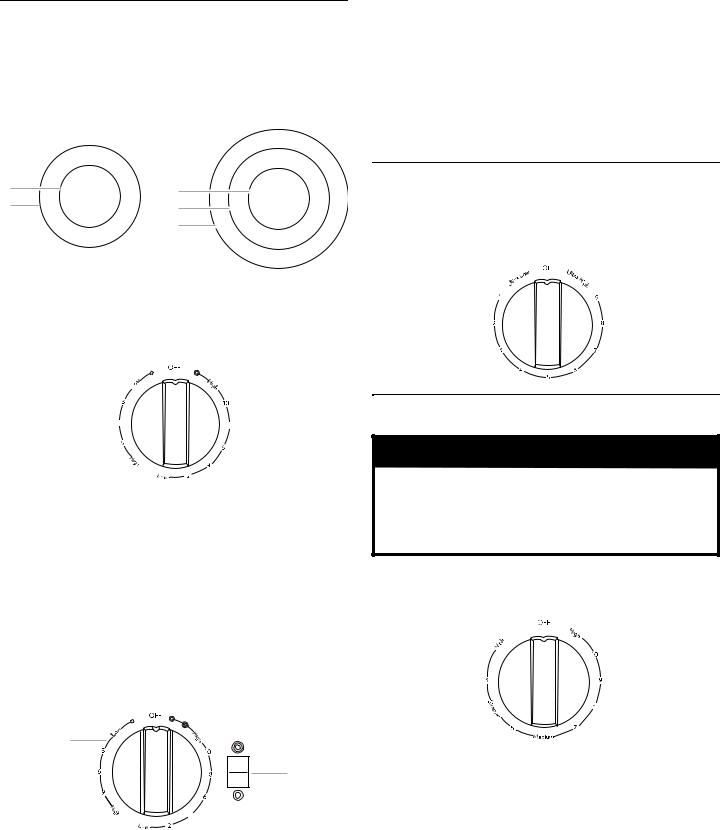
Dual and Triple Elements
(on some models)
The Dual and Triple elements offer flexibility depending on the size of the cookware. Single size can be used in the same way as a regular element. The dual and triple sizes combine the single, dual, and outer element and is recommended for larger cookware, larger quantities of food and home canning.
A A
B B
C
A. Single size |
A. Single size |
B. Dual size |
B. Dual size |
|
C. Triple size |
To Use the Dual Element:
To operate the Single element:
1.Push in and turn the control knob counterclockwise to anywhere between LOW and HIGH.
2.Turn knob to OFF when finished.
To operate the Dual or Triple elements:
1.Press the rocker switch up to use the Triple element or down to use the Dual element.
2.Push in and turn the control knob clockwise to anywhere between LOW and HIGH.
3.Turn knob to OFF when finished.
Custom Control Element
(on some models)
The Custom Control Element is a dual element that uses an electronic sensor to constantly monitor and adjust heat output for precise temperature control.
A 


 B
B
Cook and Warm Element
A.Single element control - left side
B.Dual element control - right side
To operate the Single element:
1.Push in and turn the control knob counterclockwise from the OFF position to the Single zone anywhere between LOW and HIGH.
2.Push in and turn knob to OFF when finished.
To operate the Dual element:
1.Push in and turn the control knob clockwise from the OFF position to the Dual zone anywhere between LOW and HIGH.
2.Push in and turn knob to OFF when finished.
To Use the Triple Element:
 WARNING
WARNING
Food Poisoning Hazard
Do not let food sit for more than one hour before or after cooking.
Doing so can result in food poisoning or sickness.
The Cook and Warm element is a fully functioning element that provides an ultra low Melt heat setting that is ideal for melting chocolate or butter.
A
The Melt setting is located between 3 and OFF. Heat settings C outside of this area function as a normal element. Use setting 3
as the Low setting.
IMPORTANT: When switching from use of the normal settings to 
 B the Melt setting, it may take a few minutes for the cooking area to
B the Melt setting, it may take a few minutes for the cooking area to
cool to the Melt temperature.
A.Single element control - left side
B.Dual/Triple element control - right side
C.Dual/Triple rocker switch
6
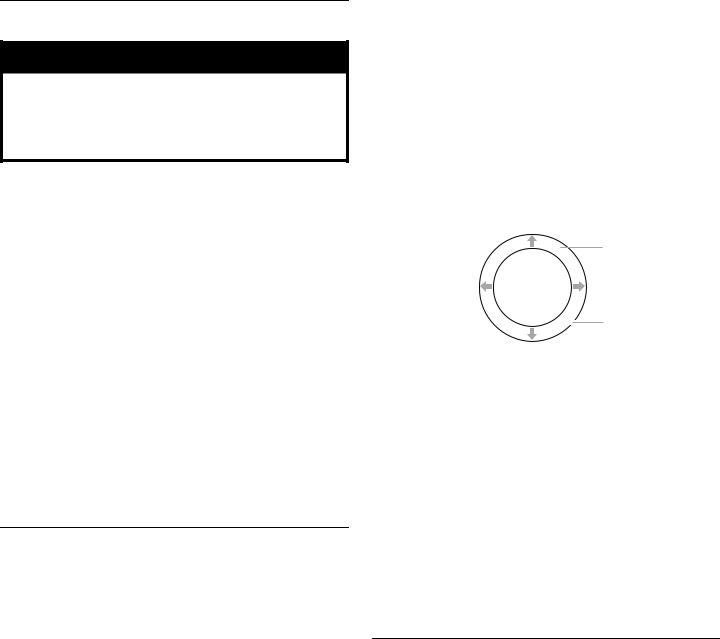
Warm Zone
 WARNING
WARNING
Food Poisoning Hazard
Do not let food sit for more than one hour before or after cooking.
Doing so can result in food poisoning or sickness.
Use the Warm Zone element to keep cooked foods warm. One hour is the recommended maximum time to maintain food quality.
Do not use it to heat cold foods.
The Warm Zone element can be used alone or when any of the other surface cooking areas are being used.
The Warm Zone element area will not glow red when cycling on. However, the Element On light will glow while the Warm Zone element is in use. The Hot Surface light will glow as long as the Warm Zone element area is too hot to touch.
■Use only cookware and dishes recommended for oven and cooktop use.
■Cover all foods with a lid or aluminum foil. When warming baked goods, allow a small opening in the cover for moisture to escape.
■To avoid damage to the cooktop, do not use plastic wrap to cover food because the plastic wrap may melt.
■Use pot holders or oven mitts to remove food.
To Use:
1.To turn on, press WARM ZONE.
2.Press the Quickset pad for HIGH or LOW.
3.To turn off, press WARM ZONE.
Ceramic Glass
(on some models)
The surface cooking area will glow red when an element is on. It may cycle on and off to maintain the selected heat level.
It is normal for the surface of light colored ceramic glass to appear to change color when surface cooking areas are hot. As the glass cools, it will return to its original color.
Cleaning off the cooktop before and after each use will help keep it free from stains and provide the most even heating. On cooktops with light colored ceramic glass, soils and stains may be more visible, and may require more cleaning and care. Cooktop cleaner and a cooktop scraper are recommended. For more information, see “General Cleaning” section.
■Avoid storing jars or cans above the cooktop. Dropping a heavy or hard object onto the cooktop could crack the cooktop.
■To avoid damage to the cooktop, do not leave a hot lid on the cooktop. As the cooktop cools, air can become trapped between the lid and the cooktop, and the ceramic glass could break when the lid is removed.
■For foods containing sugar in any form, clean up all spills and soils as soon as possible. Allow the cooktop to cool down slightly. Then, while wearing oven mitts, remove the spills using a scraper while the surface is still warm. If sugary spills are allowed to cool down, they can adhere to the cooktop and can cause pitting and permanent marks.
■To avoid scratches, do not slide cookware or bakeware across the cooktop. Aluminum or copper bottoms and rough finishes on cookware or bakeware could leave scratches or marks on the cooktop.
■Do not cook popcorn in prepackaged aluminum containers on the cooktop. They could leave aluminum marks that cannot be removed completely.
■To avoid damage to the cooktop, do not allow objects that could melt, such as plastic or aluminum foil, to touch any part of the entire cooktop.
■To avoid damage to the cooktop, do not use the cooktop as a cutting board.
■Use cookware about the same size as the surface cooking area. Cookware should not extend more than ½" (1.3 cm) outside the area.
B
A
C
A.Surface cooking area
B.Cookware/canner
C.½" (1.3 cm) maximum overhang
■Use flat-bottomed cookware for best heat conduction and energy efficiency. Cookware with rounded, warped, ribbed or dented bottoms could cause uneven heating and poor cooking results.
■Determine flatness by placing the straight edge of a ruler across the bottom of the cookware. While you rotate the ruler, no space or light should be visible between it and the cookware.
■Cookware designed with slightly indented bottoms or small expansion channels can be used.
■Make sure the bottoms of pots and pans are clean and dry before using them. Residue and water can leave deposits when heated.
■To avoid damage to the cooktop, do not cook foods directly on the cooktop.
Home Canning
When canning for long periods, alternate the use of surface cooking areas, elements or surface burners between batches. This allows time for the most recently used areas to cool.
■Center the canner on the grate or largest surface cooking area or element. On electric cooktops, canners should not extend more than ½" (1.3 cm) beyond the surface cooking area or element.
■Do not place canner on 2 surface cooking areas, elements or surface burners at the same time.
■On ceramic glass models, use only flat-bottomed canners.
■For more information, contact your local agricultural department. Companies that manufacture home canning products can also offer assistance.
7
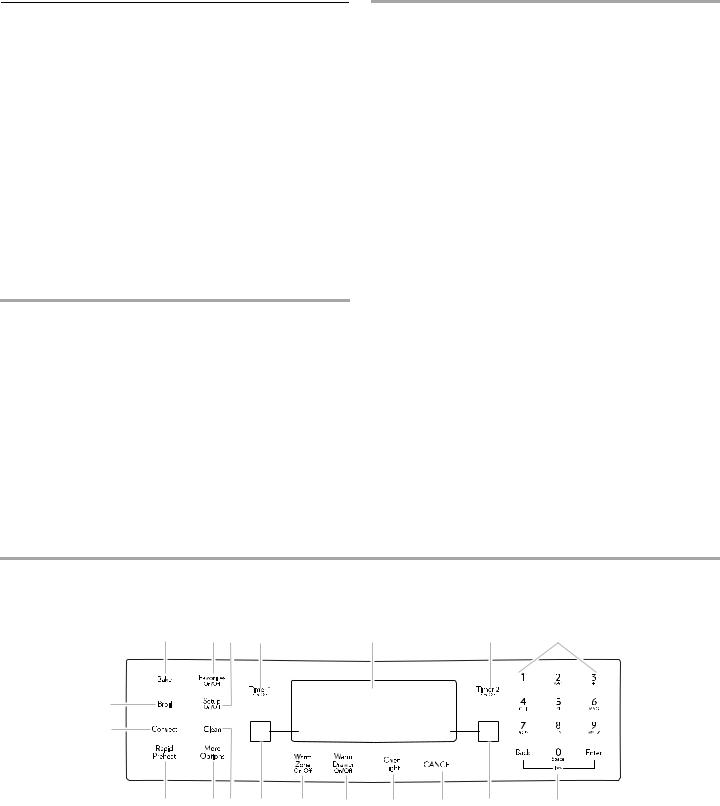
Cookware
IMPORTANT: Do not leave empty cookware on a hot surface cooking area, element or surface burner.
Ideal cookware should have a flat bottom, straight sides and a well-fitting lid, and the material should be of medium-to-heavy thickness.
Rough finishes may scratch the cooktop or grates. Aluminum and copper may be used as a core or base in cookware. However, when used as a base they can leave permanent marks on the cooktop or grates.
Cookware material is a factor in how quickly and evenly heat is transferred, which affects cooking results. A nonstick finish has the same characteristics as its base material. For example, aluminum cookware with a nonstick finish will take on the properties of aluminum.
Cookware with nonstick surfaces should not be used under the broiler.
Use the following chart as a guide for cookware material characteristics.
COOKWARE |
CHARACTERISTICS |
|
|
Aluminum |
■ Heats quickly and evenly. |
|
■ Suitable for all types of cooking. |
|
■ Medium or heavy thickness is best for |
|
most cooking tasks. |
|
|
Cast iron |
■ Heats slowly and evenly. |
|
■ Good for browning and frying. |
|
■ Maintains heat for slow cooking. |
COOKWARE |
CHARACTERISTICS |
|
|
|
|
Ceramic or |
■ |
Follow manufacturer’s instructions. |
Ceramic glass |
■ Heats slowly, but unevenly. |
|
|
||
|
■ Ideal results on low to medium heat |
|
|
|
settings. |
|
|
|
Copper |
■ Heats very quickly and evenly. |
|
|
|
|
Earthenware |
■ |
Follow manufacturer’s instructions. |
|
■ Use on low heat settings. |
|
|
|
|
Porcelain |
■ See stainless steel or cast iron. |
|
enamel-on- |
|
|
steel or cast |
|
|
iron |
|
|
|
|
|
Stainless steel |
■ Heats quickly, but unevenly. |
|
|
■ A core or base of aluminum or copper |
|
|
|
on stainless steel provides even |
|
|
heating. |
|
|
|
ELECTRONIC OVEN CONTROLS
JES8850, JES8860
A |
B C |
D |
E |
F |
H
I
J |
K L |
M |
N |
O |
P |
Q |
M |
A. Bake |
F. Timer 2 |
K. More options |
B. Favorites |
G. Number pads |
L. Clean |
C. Setup |
H. Broil |
M. Quickset pads |
D. Timer 1 |
I. Convect |
N. Warm zone |
E. Display |
J. Rapid preheat |
|
G
R
O. Warm drawer P. Oven light
Q.Cancel
R.Lock
8
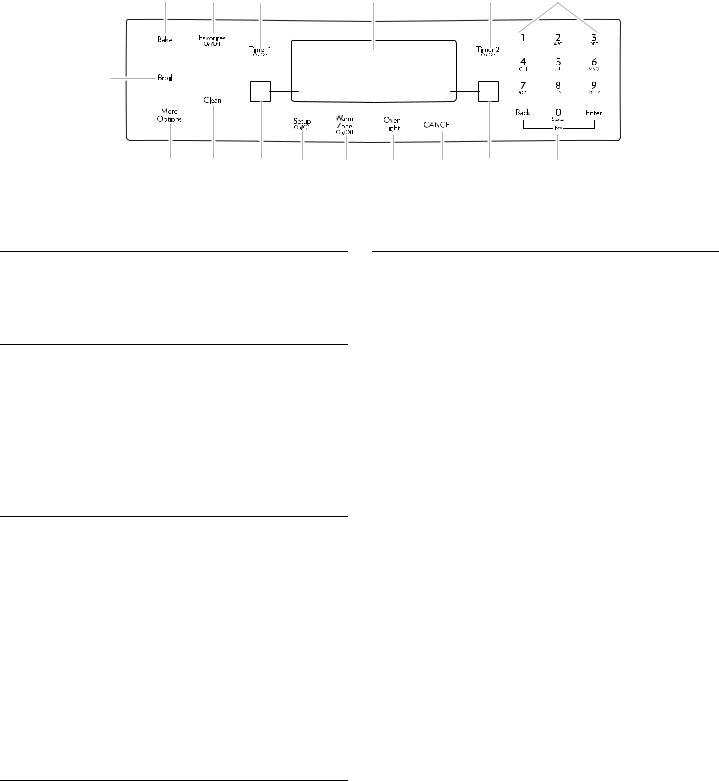
JES8750
A B C D E F
G
H |
I |
J |
K |
L |
A. Bake |
|
|
E. Timer 2 |
|
B. Favorites |
|
|
F. Number pads |
|
C. Timer 1 |
|
|
G. Broil |
|
D. Display |
|
|
H. More options |
|
Electronic Control Pads
When pressing any control pad function on the Electronic Oven Control, use the pad of your finger to press the desired function. Hold down the pad a few seconds, or until the desired function appears in the display.
Oven Display
When power is supplied to the range or after a power interruption, “12:00” and “POWER LOSS” will be displayed. Press CANCEL to clear “POWER LOSS.”
When the oven is in use, the display shows the time of day, temperature, and oven setting.
When the oven is not is use, the display shows the time of day.
When using the Timer, for settings of 1 to 59 minutes, the display will count down in minutes and seconds. For settings of 1 hour or more, the display will count down hours and minutes.
Quickset Pads
Quickset pads are located on each side of the display window and are used to select the desired function or option in the display window. To select the option or function, press the Quickset pad next to the word.
If you need to back out of a function or option in the display, press the BACK pad. When your programming is complete, press the ENTER pad or wait 4 seconds and the function will start automatically.
Up arrows indicate additional screens with additional options. Press the QUICKSET pads next to the arrows to scroll through the display.
IMPORTANT: Four seconds after entering the function, option, number or letter, the function will automatically be entered. If more than 30 seconds elapse between steps in programming, the function will be canceled and the display will return to the previous display.
Cancel
The CANCEL button stops any function except the Clock, Timer and Control Lock. When you press the CANCEL button, the display will show the time of day, or the time remaining if the TIMER is being used.
M |
N |
J |
O |
|
I. Clean |
|
M. Oven light |
|
J. Quickset pads |
|
N. Cancel |
|
K. Setup |
|
O. Lock |
|
L. Warm zone |
|
|
Clock
To Set Clock:
1.Press SETUP.
2.Select CLOCK using the left Quickset pad.
3.Select TIME using the left Quickset pad.
4.Enter the time using the number pads.
5.Press ENTER on the number pads.
6.Select AM or PM in 12-hour mode. (For 24-hour clock, see the following.)
7.To exit the Setup mode, press SETUP.
Entering the Day of the Week:
1.Press SETUP.
2.Select CLOCK using the left Quickset pad.
3.Press the right Quickset pad to scroll until DAY is displayed.
4.Select DAY using the left Quickset pad.
5.Use right Quickset pad to scroll through the days.
6.Select the day desired using the left Quickset pad.
7.To exit the Setup mode, press SETUP.
To Set the Clock for a 12or 24-Hour Format:
The clock can be set to display time in either a 12-hour or 24-hour format.
1.Press SETUP.
2.Select CLOCK using the left Quickset pad.
3.Use right Quickset pad to scroll to 12/24 HOUR.
4.Press the left Quickset pad to select 12/24 HOUR.
5.Select 12 HR or 24 HR using the right or left Quickset pad.
6.To exit Setup mode, press SETUP.
Activating and Canceling the Clock/Day of Week Display:
1.Press SETUP.
2.Select CLOCK using the left Quickset pad.
3.Press the right Quickset pad to scroll until DISABLE is displayed.
4.Select DISABLE using the left Quickset pad.
5.Select TIME using the left Quickset pad.
6.Select ON or OFF using the right or left Quickset pad to turn the clock display On or Off.
9
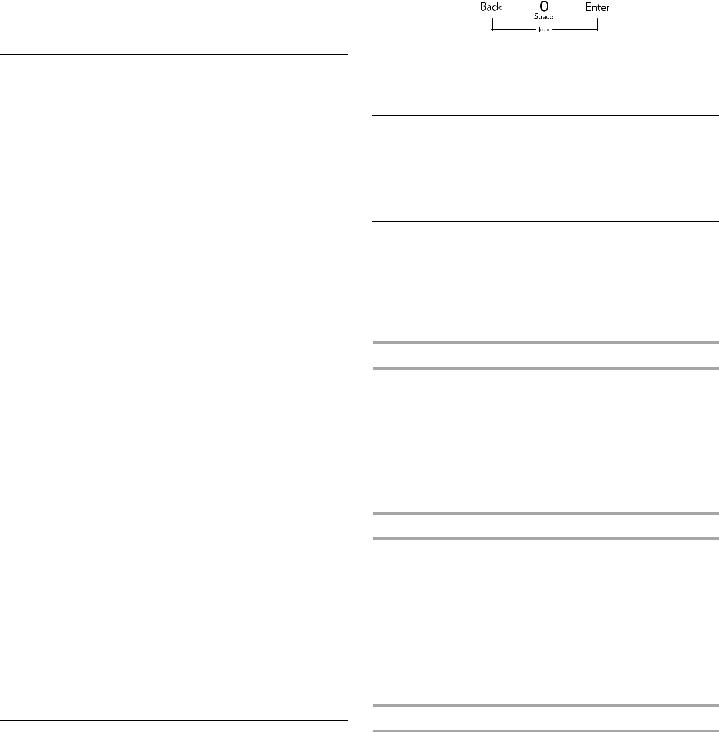
Day of the week:
7.Use right Quickset pad to scroll to DAY.
8.Select DAY using the left Quickset pad.
9.Select ON or OFF using the right or left Quickset pad to turn the Day of the Week display On or Off.
10.To exit the Setup mode, press SETUP.
Timers
Setting the Timers (Timer 1 or Timer 2):
1.Press TIMER 1 or TIMER 2.
2.Press one of the displayed times using the Quickset pads, or press the number pads to enter the desired time.
IMPORTANT: Each press of the displayed time choices adds additional time. For example, pressing “10 MIN” three times provides 30 minutes on the timer (0:30).
3. Press ENTER (located on the number pad).
Changing the Amount of Time Entered Once the Timer Starts:
1.Press TIMER 1 or TIMER 2 once.
2.Press the displayed times on the Quickset pads repeatedly until the desired time is entered.
OR
Press the number pads to enter the new desired time.
3.Press Enter pad.
Canceling the Timer:
1. Press TIMER 1 or TIMER 2 twice.
If Both Timers Are Active:
If the desired Timer is already in the foreground, press once for edit mode and twice to cancel the Timer. If the desired Timer is not in the foreground, follow these steps:
1.Press the desired TIMER pad once. The selected Timer will come to the foreground.
2.Press TIMER a second time to access the edit mode in order to make changes.
3.Pressing TIMER a third time will cancel the Timer.
Changing the Timer Beeps:
The signal beeps for TIMER 1 and TIMER 2 can be changed. The options available are 2 beeps every 30 seconds, 2 beeps every 60 seconds or 1 beep only. The default setting is 1 beep.
1.Press SETUP.
2.Use right Quickset pad to scroll to TONES.
3.Select TONES using the left Quickset pad.
4.Use right Quickset pad to scroll to TIMER TONES.
5.Select TIMER TONES using the left Quickset pad.
6.Use right Quickset pad to scroll to the desired timer beep format (2-30 SEC, 2-60 SEC or 1 BEEP).
7.Select the desired timer beep using the left Quickset pad.
8.Press SETUP to exit Setup mode.
Locking the Oven Control and Oven Door
The lock feature shuts down the control pads (buttons) and locks the oven door to avoid unintended use of the oven.
The lock feature is preset unlocked, but can be locked.
If the oven is currently in use, the controls and oven door cannot be locked.
To Lock the Oven Control and Oven Door:
Press and hold BACK and ENTER for 3 seconds or until “CONTROL LOCKED” appears in the display.
To Unlock the Oven Control and Oven Door:
Press and hold BACK and ENTER for 3 seconds. “UNLOCKING DOOR” will appear in the display when the control and door are unlocking.
Oven Light
The oven light automatically comes on when the door is opened. When the door is closed, press the OVEN LIGHT pad to turn the oven light on and off. A beep will sound every time the Oven Light pad is pressed. If the oven light is on when the door is opened, the light will go off when the door is closed.
Setup
1.Press SETUP to begin.
2.Use right Quickset pad to scroll through Setup options.
3.Select the desired option by pressing the Quickset pads.
NOTE: To back out of a screen without making any changes, press the Setup pad. The display will return to the time of day.
Clock
See the “Clock” section for more details. Use the Clock option to:
■Set the time of day.
■Set day of week.
■Select AM or PM (12-hour mode only). AM or PM will not show with the time of day in the display.
■Choose a 12or 24-hour clock display.
■Disable the clock display.
Language
The language of the screens in the display window can be set to English, French or Spanish.
To change the display language from English:
1.Press SETUP.
2.Use right Quickset pad to scroll to LANGUAGE.
3.Select LANGUAGE using the left Quickset pad.
4.Use right Quickset pad to scroll to the desired language.
5.Select the desired language using the left Quickset pad.
6.Press SETUP to exit the Setup menu.
Auto Convect Conversion (on some models)
The oven comes from the factory set for Auto Convect conversion. Auto Convect Conversion automatically reduces the set temperature by 25°F for Convect Bake and Convect Pastry. For Convect Roast the control will alert you at 75% of the programmed roasting time to check foods for doneness. Convect roast temperatures are not reduced.
NOTES:
■When using Convect Bake and Convect Pastry with the Auto Convect Conversion option turned off, reduce the set temperature by 25°F.
10
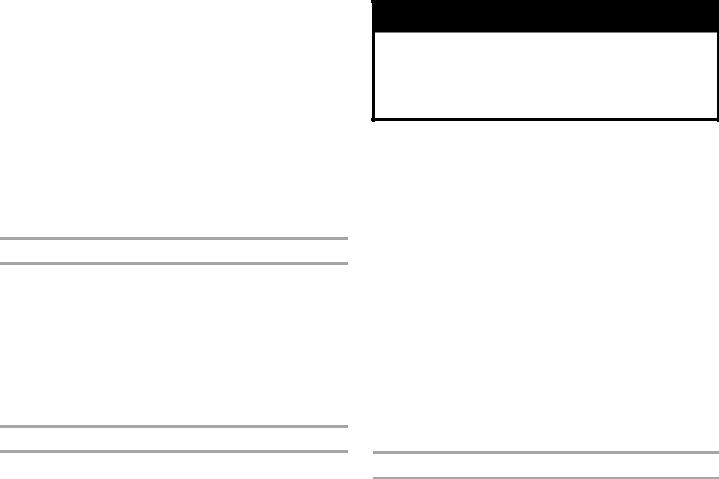
■If Convect Roasting with the Auto Convect conversion option turned off, you will not be required to program a cooking time. Check food at 75% of the conventional time.
To deactivate Auto Convect conversion:
1.Press SETUP.
2.Use right Quickset pad to scroll to AUTO CONVECT.
3.Select AUTO CONVECT using the left Quickset pad.
4.Select OFF using the Quickset pad.
5.Press SETUP to exit the Setup menu.
To reactivate Auto Convect conversion:
1.Press SETUP.
2.Use right Quickset pad to scroll to AUTO CONVECT.
3.Select AUTO CONVECT using the left Quickset pad.
4.Select ON using the Quickset pad.
5.Press SETUP to exit the Setup menu.
C/F (Celsius/Fahrenheit)
The displayed temperature scale can be changed from Fahrenheit to Celsius.
To change the scale:
1.Press SETUP.
2.Use right Quickset pad to scroll to C/F.
3.Select C/F using the left Quickset pad.
4.Select the desired temperature scale using the Quickset pads.
5.Press SETUP to exit the Setup menu.
Sabbath Mode
The oven is set to shut off after 12 hours if you unintentionally leave it on. The Sabbath Mode overrides the 12-hour shutoff and can either be set to come on automatically or can be set manually as desired.
Only Bake or Cook/Hold Bake will operate when the oven is in Sabbath Mode. All other functions are invalid. If a function other than Bake or Cook/Hold Bake is in operation when Sabbath Mode starts, the function will be canceled.
■The oven must be idle to program Sabbath Mode.
■Sabbath Mode cannot be turned on if the keypads are locked out or when the door is locked.
■If the oven is baking when Auto Sabbath Mode starts, there will be no audible beeps.
■All prompts, messages and beeps are deactivated when the Sabbath Mode is active.
■If the oven light is desired while in Sabbath Mode, it must be turned on before the Sabbath Mode is set.
■The self-clean cycle and automatic door lock do not operate during the Sabbath Mode.
■The Bake temperature can be changed during an Active Sabbath Mode. Simply press the Bake pad and then enter the desired temperature using the Quickset pads.
■Pressing the Cancel pad will cancel a Bake cycle, however the control will stay in the Sabbath Mode.
■The day of the week and AM/PM must be set for Sabbath Auto Mode to operate correctly.
To activate Sabbath mode:
 WARNING
WARNING
Food Poisoning Hazard
Do not let food sit in oven more than one hour before or after cooking.
Doing so can result in food poisoning or sickness.
1.Press SETUP.
2.Use right Quickset pad to scroll to SABBATH.
3.Select SABBATH using the left Quickset pad.
4.Select AUTO or MANUAL.
AUTO will automatically prompt you to enter a Bake temperature on Friday at 2 p.m. and stay in Sabbath mode for 33 hours. “SABBATH” and “SABBATH ENABLE” appear in the display for 90 minutes. If Bake or Cook/Hold Bake are desired during Sabbath Mode, they must be programmed during this 90-minute period before AUTO Sabbath Mode is active.
MANUAL sets the oven to Sabbath Mode for 72 hours. “SABBATH” and “SABBATH ENABLE” appear in the display for 5 minutes. If Bake or Cook/Hold Bake are desired during Sabbath Mode, they must be programmed during this 5-minute period before the MANUAL Sabbath Mode is active.
5.Select ON or OFF.
To cancel Sabbath mode:
1.Press CANCEL.
2.Press and hold SETUP for 5 seconds.
Temp Adjust
Oven temperatures are tested at the factory. It is normal to notice some baking time or browning differences between a new oven and an old one. As ovens get older, the oven temperature can shift.
You may adjust the oven temperature if you think the oven is not baking or browning correctly. To decide how much to change the temperature, set the oven temperature 25°F higher or lower than the temperature in your recipes, then bake. The results of the first bake should give you an idea of how much to adjust the temperature.
To adjust the oven temperature:
1.Press SETUP.
2.Use right Quickset pad to scroll to TEMP ADJUST.
3.Select TEMP ADJUST using the left Quickset pad.
4.Enter the desired temperature change using the number pads.
5.Use the Quickset pads to select “+/-” to indicate an increase or decrease in temperature. The temperature change is displayed at the top of the window.
6.Press ENTER or wait 3 seconds to accept the change.
7.Press SETUP to exit the menu.
The oven temperature does not need to be readjusted if there is a power failure or interruption.
Broiling and cleaning temperatures cannot be adjusted.
11

208/240V
For improved results when using Bake, the oven can be set from 240V to 208V if your household is on 208V.
To set the oven to 208V:
1.Press SETUP.
2.Use right Quickset pad to scroll to 208/240V.
3.Select 208/240V using the left Quickset pad.
4.Select 208V or 240V using the Quickset pads.
5.Press SETUP to exit the menu.
Tones (beeps)
The number of beeps heard at the end of cooking and at the end of timer operation and their volume can be adjusted.
To change the beeps at the end of cooking:
1.Press SETUP.
2.Use right Quickset pad to scroll to TONES.
3.Select TONES using the left Quickset pad.
4.Use right Quickset pad to scroll to COOK TONE.
5.Select COOK TONE using the left Quickset pad.
6.Use the right Quickset pad to scroll and select: 1-30 SEC to hear 1 beep every 30 seconds.
OR
1-60 SEC to hear 1 beep every 60 seconds.
OR
1 BEEP to hear 1 beep only at the end of cooking.
7.Select the desired cook tone using the left Quickset pad.
8.Press SETUP to exit.
To change the timer beeps:
1.Press SETUP.
2.Use right Quickset pad to scroll to TONES.
3.Select TONES using the left Quickset pad.
4.Use right Quickset pad to scroll to TIMERS TONES.
5.Select TIMERS TONES using the left Quickset pad.
6.Use the right Quickset pad to scroll and select: 1-30 SEC to hear 1 beep every 30 seconds.
OR
1-60 SEC to hear 1 beep every 60 seconds.
OR
1 BEEP to hear 1 beep only at the end of cooking.
7.Select the desired cook tone using the left Quickset pad.
8.Press SETUP to exit.
To change the volume of the beeps:
1.Press SETUP.
2.Use right Quickset pad to scroll to TONES.
3.Select TONES using the left Quickset pad.
4.Use right Quickset pad to scroll to VOLUME.
5.Select VOLUME using the left Quickset pad.
6.Use right Quickset pad to scroll and select: HIGH for the highest volume.
OR
MEDIUM for medium volume.
OR
LOW for the lowest volume.
7.Select the desired volume using the left Quickset pad.
8.Press SETUP to exit.
12 HR Shutoff
The oven will automatically turn off at the end of 12 hours if you unintentionally leave it on.
To turn off this feature:
1.Press SETUP.
2.Use right Quickset pad to scroll to 12HR SHUTOFF.
3.Select 12HR SHUTOFF using the left Quickset pad.
4.Select ON or OFF using the Quickset pads.
5.Press SETUP to exit.
Energy Saver
To save energy, the display can be set to go dark if it is not being used.
To set the Energy Saver feature:
1.Press SETUP.
2.Use right Quickset pad to scroll to ENERGY SAVER.
3.Select ENERGY SAVER using the left Quickset pad.
4.Select ON or OFF using the Quickset pads.
5.Press SETUP to exit.
Press any pad to “wake up” the display.
Service
This area of the oven control displays the Jenn-Air Customer eXperience Center toll-free phone number.
1.Press SETUP.
2.Use right Quickset pad to scroll to SERVICE.
3.Select SERVICE using the left Quickset pad to display the number.
4.Press SETUP to exit.
Demo
When Demo is selected, you will see a short presentation highlighting the features of the range.
1.Press SETUP.
2.Use right Quickset pad to scroll to DEMO.
3.Select DEMO using the left Quickset pad.
4.Select ON using the left Quickset pad.
5.Press SETUP to exit.
12

OVEN USE
Odors and smoke are normal when the oven is used the first few times, or when it is heavily soiled.
IMPORTANT: The health of some birds is extremely sensitive to the fumes given off. Exposure to the fumes may result in death to certain birds. Always move birds to another closed and wellventilated room.
Aluminum Foil
IMPORTANT: To avoid permanent damage to the oven bottom finish, do not line the oven bottom with any type of foil or liner.
■For best cooking results, do not cover entire rack with foil because air must be able to move freely.
■To catch spills, place foil on rack below dish. Make sure foil is at least ½" (1.3 cm) larger than the dish and that it is turned up at the edges.
Positioning Racks and Bakeware
IMPORTANT: To avoid permanent damage to the porcelain finish, do not place food or bakeware directly on the oven door or bottom.
Racks
■Depending on your model, 2 or 3 standard flat racks are included.
■Position racks before turning on the oven.
■Do not position racks with bakeware on them.
■Make sure racks are level.
To Remove Oven Racks:
Pull rack out to the stop position, raise the front edge, and then pull out.
To Replace Oven Racks:
Place rack on the rack support in the oven. Tilt the front edge up slightly, and slide rack back until it clears the stop position. Lower front and slide back into the oven.
Rack Positions
5
4
3
2
1
Traditional Cooking
FOOD |
RACK POSITION |
2-rack cooking and broiling. |
5 |
|
|
2-rack baking and broiling. |
4 |
|
|
Most baked goods on a cookie sheet or |
3 |
jelly roll pan, layer cakes, fruit pies, |
|
frozen convenience foods. |
|
|
|
Roasting small cuts of meat, |
2 |
casseroles, baking loaves of bread, |
|
bundt cakes, custard pies, frozen pies |
|
or 2-rack baking. |
|
|
|
Large cuts of meat and poultry, dessert |
1 |
souffles, angel food cake, or 2-rack |
|
baking. |
|
|
|
Multiple Rack Cooking
Two rack: Use rack positions 2 and 5 or 1 and 4.
Convection Cooking (on some models)
FUNCTION |
NUMBER OF |
RACK |
|
RACKS USED |
POSITION(S) |
|
|
|
Convection baking or |
1 |
1, 2 or 3 |
roasting |
|
|
|
|
|
Convection baking |
2 |
2 and 4 |
|
|
|
Convection baking |
3 |
1, 3 and 5 |
|
|
|
Multiple Rack Convection Cooking
Three rack (on some models): Use rack positions 1, 3 and 5.
NOTE: When convect baking on 2 or 3 racks, check foods at the minimum suggested time to avoid overbrowning or overcooking.
Baking Layer Cakes on Two Racks
For best results when baking cakes on 2 racks with or without convection (on some models), use racks 2 and 5. Place the cakes on the rack as shown.
13
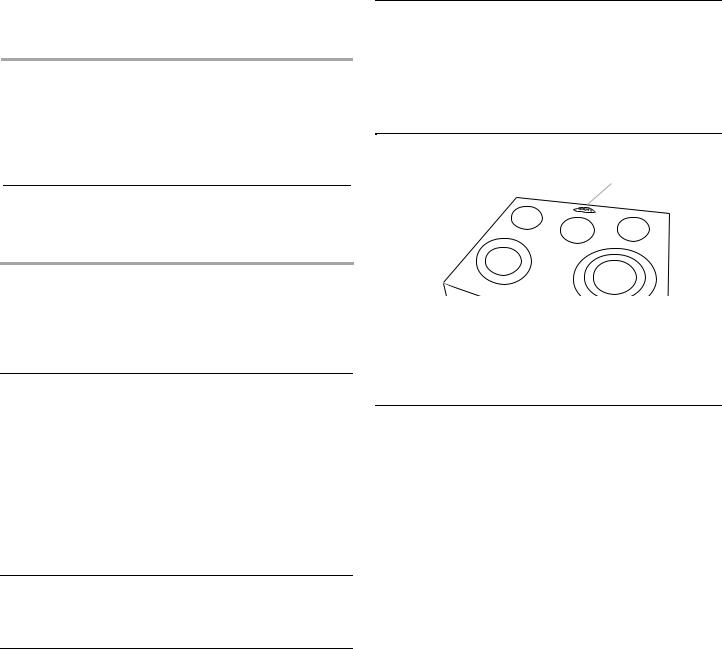
BAKEWARE
To cook food evenly, hot air must be able to circulate. Allow 2" (5.0 cm) of space around bakeware and oven walls. Use the following chart as a guide.
NUMBER |
POSITION ON RACK |
OF PAN(S) |
|
|
|
1 |
Center of rack. |
|
|
2 |
Side by side or slightly staggered. |
|
|
3 or 4 |
Opposite corners on each rack. Make sure that |
|
no bakeware piece is directly over another. |
Meat Thermometer
On models without a temperature probe, use a meat thermometer to determine whether meat, poultry and fish, are cooked to the desired degree of doneness. The internal temperature, not appearance, should be used to determine doneness. A meat thermometer is not supplied with this appliance. Follow manufacturer's directions for using a meat thermometer.
Oven Vent
A
Bakeware
The bakeware material affects cooking results. Follow manufacturer’s recommendations and use the bakeware size recommended in the recipe. Use the following chart as a guide.
BAKEWARE/ |
RECOMMENDATIONS |
RESULTS |
|
|
|
Light colored |
■ Use temperature and time |
aluminum |
recommended in recipe. |
■Light golden crusts
■Even browning
Dark aluminum and |
■ |
May need to reduce baking |
|
other bakeware with |
|
temperatures slightly. |
|
dark, dull and/or |
■ |
Use suggested baking time. |
|
nonstick finish |
|||
■ For pies, breads and casseroles, |
|||
■ Brown, crisp |
|||
|
use temperature recommended in |
||
crusts |
|
||
|
recipe. |
||
|
|
||
|
■ Place rack in center of oven. |
||
|
|
|
|
Insulated cookie |
■ |
Place in the bottom third of oven. |
|
sheets or baking |
■ |
May need to increase baking time. |
|
pans |
|||
|
|
||
■Little or no bottom browning
Stainless steel |
■ May need to increase baking time. |
■Light, golden crusts
■Uneven browning
Stoneware/Baking |
■ Follow manufacturer’s instructions. |
|
stone |
|
|
■ |
Crisp crusts |
|
|
|
|
Ovenproof |
■ May need to reduce baking |
|
glassware, ceramic |
temperatures slightly. |
|
glass or ceramic |
|
|
■ |
Brown, crisp |
|
|
crusts |
|
|
|
|
A. Oven vent
The oven vent releases hot air and moisture from the oven, and should not be blocked or covered. Blocking or covering the vent will cause poor air circulation, affecting cooking and cleaning results. Do not set plastics, paper or other items that could melt or burn near the oven vent.
Bake
The BAKE function is ideal for baking, roasting or heating foods.
During baking or roasting, the bake and broil elements will cycle on and off in intervals to maintain oven temperature.
To Bake:
Before baking, position racks according to the “Positioning Racks and Bakeware” section.
For baking, allow the range to preheat before placing food in the oven.
1.Press BAKE.
2.Select the oven temperature using the Quickset pads.
OR
Enter the desired temperature using the number pads. The temperature can be set from 170°F (80°C) to 550°F (288°C) in 5° (1° in Celsius) increments.
3.Press ENTER to set.
After 3 seconds, the oven will begin to preheat. “BAKE” and “PREHEAT” will appear in the display along with “100°” (“38°” in Celsius) or the actual oven temperature, whichever is higher.
The temperature in the display will increase in 1° increments until the oven reaches the preset temperature. Allow about 15 minutes for the oven to preheat.
When the oven is preheated, the oven will beep and “PREHEAT” will disappear from the display.
To change the oven temperature during cooking, press BAKE and select a displayed temperature or use the number pads to enter the desired temperature.
4.Press CANCEL when finished cooking. Remove food from the oven.
14

Broil
Broiling uses direct radiant heat to cook food. Changing the temperature when broiling allows more precise control when cooking. The lower the temperature, the slower the cooking. Thicker cuts and unevenly shaped pieces of meat, fish and poultry may cook better at lower broiling temperatures.
■For best results, use a broiler pan and grid. They are designed to drain juices and help avoid spatter and smoke.
If you would like to purchase a broiler pan, one may be ordered. See “Assistance or Service” section to order. Ask for Part Number 4396923.
■For proper draining, do not cover the grid with foil. The bottom of the pan may be lined with aluminum foil for easier cleaning.
■Trim excess fat to reduce spattering. Slit the remaining fat on the edges to avoid curling.
■Pull out oven rack to stop position before turning or removing food. Use tongs to turn food to avoid the loss of juices. Very thin cuts of fish, poultry or meat may not need to be turned.
■After broiling, remove the pan from the oven when removing the food. Drippings will bake on the pan if left in the heated oven, making cleaning more difficult.
Before broiling, position rack according to the Broiling Chart. Preheat broil for about 5 minutes. Position food on grid in the broiler pan, then place it in the center of the oven rack. Close the door to the broil stop position to ensure proper broiling temperature.
To Broil:
Before broiling, position rack according to the Broiling Chart.
1.Press BROIL.
2.“HIGH” and “LOW” will be displayed.
Use the Quickset pads to select HIGH (550°F/290°C) for normal broiling or LOW (450°F/230°C) for low-temperature broiling.
OR
To select a broil temperature other than High or Low, enter the desired temperature (300°F/149°C to 550°F/288°C) using the number pads and press ENTER.
3.Press CANCEL when finished.
BROILING CHART
For best results, place food 3" (7.0 cm) or more from the broil element. Times are guidelines only and may need to be adjusted for individual tastes. Recommended rack positions are numbered from the bottom (1) to the top (5). For diagram, see the “Positioning Racks and Bakeware” section.
FOOD |
RACK |
TOTAL |
|
|
POSITION |
TIME |
|
|
|
MIN. |
|
|
|
|
|
Steak |
|
|
|
1" (2.5 cm) thick |
|
|
|
medium |
4 |
18-20 |
|
well-done |
4 |
18-22 |
|
|
|
|
|
Ground meat patties |
|
|
|
½" (1.3 cm) thick |
|
|
|
well-done |
4 |
10-12 |
|
|
|
|
|
Pork chops |
|
|
|
1" (2.5 cm) thick |
|
|
|
Bone-in |
4 |
25-28 |
|
Boneless |
4 |
20-28 |
|
|
|
|
|
Ham slice, precooked |
|
|
|
1" (2.5 cm) thick |
|
|
|
warm |
4 |
12-16 |
|
|
|
|
|
Chicken |
|
LOW broil |
|
bone-in breasts |
3 |
20-33 |
|
boneless, skinless breasts |
4 |
12-15 |
|
|
|
|
|
Seafood |
|
|
|
Fish Steaks |
|
|
|
1" (2.5 cm) thick |
|
|
|
flaky |
3 or 4 |
10-14 |
|
Lobster tails |
4 |
7-10 |
|
3-4 oz (85-113 g) each |
|||
|
|
Convection Cooking
(on some models)
In a convection oven, the fan-circulated hot air continually distributes heat more evenly than the natural movement of air in a standard thermal oven. This movement of hot air helps maintain a consistent temperature throughout the oven, cooking foods more evenly, crisping surfaces while sealing in moisture and yielding crustier breads.
Most foods can be cooked by lowering cooking temperatures 25°F to 50°F (14°C to 28°C), and cooking time can be shortened by as much as 30 percent, especially for large turkeys and roasts.
■It is important not to cover foods with lids or aluminum foil so that surface areas remain exposed to the circulating air, allowing browning and crisping.
■Keep heat loss to a minimum by opening the oven door only when necessary.
■Choose cookie sheets without sides and roasting pans with lower sides to allow air to move freely around the food.
15
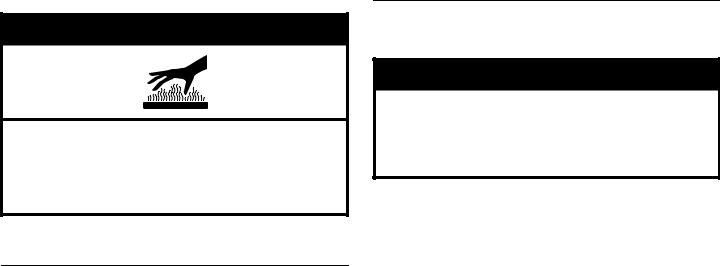
■Test baked goods for doneness a few minutes before the minimum cooking time with a method such as using a toothpick.
 WARNING
WARNING
Burn Hazard
Use an oven mitt to remove temperature probe. Do not touch broil element.
Failure to follow these instructions can result in burns.
■Use a meat thermometer or the temperature probe (on some models) to determine the doneness of meats and poultry.
Convect Bake
(on some models)
Convect Bake can be used to bake and cook foods on single or multiple racks. It is helpful to stagger items on the racks to allow a more even flow of heat. If the oven is full, extra cooking time may be needed.
When cooking an oven meal with several different types of foods, be sure to select recipes that require similar temperatures. Cookware should sit in the oven with at least 1" (2.5 cm) of space between the cookware and the sides of the oven.
Allow the range to preheat before placing food in the oven.
During convection baking preheat, the broil elements and the bake element all heat the oven cavity. After preheat, the convection element will cycle on and off in intervals to maintain oven temperature, while the fan constantly circulates the hot air.
If the oven door is opened during convection baking or preheating, the convection element and fan will turn off immediately. They will come back on once the door is closed.
■Reduce recipe temperature 25°F (14°C). The cook time may need to be reduced also.
To Convect Bake:
Before convection baking, position racks according to the “Positioning Racks and Bakeware” section.
1.Press CONVECT.
2.Select CNVT BAKE using the left Quickset pad.
3.Select the oven temperature using the Quickset pads.
OR
Press the number pads to enter a temperature. The temperature can be set between 195°F and 550°F (91°C and 288°C) in 5° increments when Auto Convect is on. If Auto Convect is off, temperature can be set from 170°F (77°C).
4.Press ENTER.
After 3 seconds, the oven will begin to preheat. “CNVT BAKE” and “PREHEAT” will appear in the display along with 100° or the actual oven temperature, whichever is higher.
The temperature in the display will increase in 1° increments until the oven reaches the preset temperature. Allow about 15 minutes for the oven to preheat.
When the oven is preheated, the oven will beep, “PREHEAT” will turn off and “CNVT BAKE” will be displayed. “AUTO” will be displayed if Auto Convect conversion feature is turned on.
5.Place food in the oven.
6.Press CANCEL when finished cooking.
Convect Roast
(on some models)
 WARNING
WARNING
Food Poisoning Hazard
Do not let food sit in oven more than one hour before or after cooking.
Doing so can result in food poisoning or sickness.
Convection Roast can be used to roast meat and poultry, and vegetables.
To Convect Roast:
Before convection roasting, position racks according to the “Positioning Racks and Bakeware” section. It is not necessary to wait for the oven to preheat before putting food in, unless recommended in the recipe. If a recipe suggest preheating the oven, add 15 minutes to the cook time.
1.Place food in the oven.
2.Press CONVECT.
3.Use the right Quickset pad to scroll to CNVT ROAST.
4.Select CNVT ROAST using the left Quickset pad.
5.Select the oven temperature using the Quickset pads.
OR
Enter the desired temperature using the number pads.
The temperature can be set between 170°F and 550°F (77°C and 288°C).
6.Press ENTER pad to set.
7.Select the cook time using the Quicket pads.
OR
Enter desired the time using the number pads.
8.Press ENTER pad to set.
NOTE: If Auto Convect is off, a roast time will not be required.
After 3 seconds, the oven will begin to heat. “CNVT ROAST” will appear in the display along with “100°” or the actual oven temperature, whichever is higher.
The temperature in the display will increase in 1° increments until the oven reaches the preset temperature.
Cook time will begin to count down.
9.At 75% of the cooking time the oven will beep to let you know to check food. Check food using a meat thermometer.
If food is done, take food out of oven and press CANCEL pad to turn oven off.
If food is not done, continue roasting.
Once the set time has elapsed the oven will automatically go into Keep Warm mode for 1 hour and then shut off. If food is taken from the oven before the hour has elapsed, press the CANCEL pad.
16
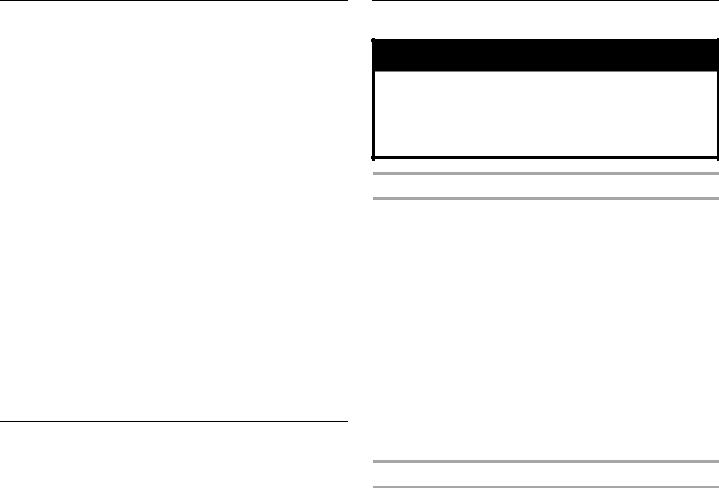
Convect Pastry
(on some models)
Convect Pastry is designed to bake pastry items such as frozen pies, turnovers, cream puffs and puff pastry. Use 1, 2 or 3 racks while using this feature.
1.Press CONVECT.
2.Use the right Quickset pad to scroll to CNVT PASTRY.
3.Select CNVT PASTRY using the left Quickset pad.
4.Select the oven temperature using the Quickset pads.
OR
Enter the desired temperature using the number pads.
The temperature can be set between 195°F and 550°F (91°C and 288°C) in 5° increments.
5.Press ENTER pad to set.
After 3 seconds, the oven will begin to preheat. “CNVT PASTRY” and “PREHEAT” will appear in the display along with “100°” or the actual oven temperature, whichever is higher. AUTO will display if the Auto Convect conversion feature is turned on.
The temperature in the display will increase in 1° increments until the oven reaches the preset temperature. Allow about 15 minutes for the oven to preheat.
When the oven is preheated, the oven will beep, “PREHEAT” will turn off and “CNVT PASTRY” will be displayed.
6.Press CANCEL when finished cooking.
Rapid Preheat
(on some models)
Use Rapid Preheat to decrease preheating time when using Bake or Convect Bake. Use for all foods when baking on 1 rack.
For best results, use rack position 2 or 3 when using the Rapid Preheat option.
For optimum baking and browning results, Rapid Preheat is not recommended when baking on multiple racks.
To Activate:
After Bake or Convect Bake has been programmed and activated, press RAPID PREHEAT.
“1 RACK ONLY” will display, after 10 seconds the display will show “RAPID” and “PREHEAT.”
Preheat time is 5 minutes.
To Return to Standard Preheat:
Press RAPID PREHEAT. This will provide standard preheat. “PREHEAT” and the selected function will be displayed.
More Options
 WARNING
WARNING
Food Poisoning Hazard
Do not let food sit in oven more than one hour before or after cooking.
Doing so can result in food poisoning or sickness.
Cook & Hold
1.Press MORE OPTIONS.
2.Select COOK/HOLD using the left Quickset pad.
3.Select the cook time using the Quickset pads.
OR
Enter the desired cook time using the number pads.
4.Press ENTER pad to set.
5.Select BAKE or CONVECT using the Quickset pads.
When CONVECT is pressed, scroll to CNVT BAKE, CNVT ROAST or CNVT PASTRY then select the desired function using the left Quickset pad.
6.Select the temperature using the Quickset pads.
OR
Enter the desired temperature using the number pads.
IMPORTANT: If the recipe recommends preheating the oven, add 15 minutes to the cook time.
Delay
To Set Delay Bake:
1.Press MORE OPTIONS.
2.Use the right Quickset pad to scroll to DELAY.
3.Select DELAY using the left Quickset pad.
4.Select Delay time using Quickset pads or the number pads.
5.Select BAKE.
6.Select from the displayed temperatures or use the number pads to enter the temperature.
7.Select the time to cook from the displayed times or use the number pads to enter the cooking time.
8.The display will show “DELAY TIME,” the selected function, the preset temperature and the delay time countdown.
When the delay time has expired, the cook time will be displayed and the oven will begin to preheat.
To Set Delay Convect: (on some models)
1.Press MORE OPTIONS.
2.Use the right Quickset pad to scroll to DELAY.
3.Select DELAY using the left Quickset pad.
4.Select Delay time using Quickset pads or the number pads.
5.Use the right Quickset pad to scroll to CONVECT.
6.Select CONVECT using the left Quickset pad.
7.Use the right Quickset pad to scroll to CNVT BAKE, CNVT ROAST or CNVT PASTRY.
8.Select the desired function using the left Quickset pad.
9.Select from the displayed temperatures or use the number pads to enter the temperature.
17
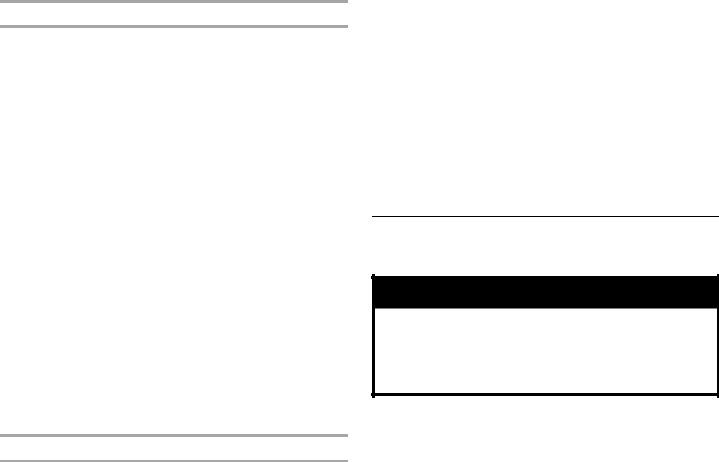
10.Select the time to cook from the displayed times or use the number pads to enter the cooking time.
The display will show “DELAY TIME,” the selected function, the preset temperature and the delay time countdown.
When the delay time has expired, the cook time will be displayed and the oven will begin to preheat.
Proofing (on some models)
The Proofing feature can be used to raise yeast-based bread products prior to baking. There are two proofing methods available – Rapid and Standard.
Standard proofing in the oven avoids damage to dough from room temperature changes or drafts that commonly affect proofing done on the countertop.
Rapid proofing provides faster proofing results than countertop or Standard proofing, without harming the yeast.
To Proof:
1.Press MORE OPTIONS.
2.Use the right Quickset pad to scroll to PROOFING.
3.Select PROOFING using the left Quickset pad.
4.Select RAPID or STANDARD using the Quickset pads.
5.Press CANCEL when finished proofing.
NOTES:
■For any dough that requires one rise, either Standard or Rapid Proofing can be used.
■When using frozen bread dough, choose RAPID PROOFING. There is no need to thaw dough before proofing.
■For dough requiring 2 rises, Standard Proofing must be used for the first rising period. Either Standard or Rapid Proofing can be used for the second rise.
■If oven temperature is too high for proofing, “OVEN COOLING” will appear in the display.
Keep Warm
IMPORTANT: Food must be at serving temperature before placing it in the warmed oven. Food may be held up to 1 hour; however, breads and casseroles may become too dry if left in the oven during Keep Warm.
The Keep Warm feature allows hot cooked foods to stay at serving temperature. It can also be used at the end of a timed cook.
Follow manufacturer’s recommendations when warming empty serving bowls and plates.
To Use:
1.Press MORE OPTIONS.
2.Use the right Quickset pad to scroll to KEEP WARM.
3.Select KEEP WARM using the left Quickset pad.
4.Select one of the displayed temperatures or enter desired temperature using the number pads. Temperatures can be selected between 145°F and 190°F (63°C and 88°C).
“KEEP WARM” and the temperature will be displayed. “PREHEAT” will be displayed until the programmed temperature is reached.
When oven has preheated, a beep sounds and “KEEP WARM” and the temperature will be displayed.
5.Press CANCEL when finished.
To Warm Dinner Rolls:
1.Cover rolls loosely with foil and place in oven.
2.Press MORE OPTIONS.
3.Use the right Quickset pad to scroll to KEEP WARM.
4.Select KEEP WARM using the left Quickset pad.
5.Select 170° (77° in Celsius) temperature. Warm for 12 to 15 minutes.
To Warm Plates:
NOTES:
Use only oven-safe plates. Check with the manufacturer.
To avoid crazing or breakage, do not set warm dishes on a cold surface.
1.Place 2 stacks of up to 4 plates each in the oven.
2.Press MORE OPTIONS.
3.Use the right Quickset pad to scroll to KEEP WARM.
4.Select KEEP WARM using the left Quickset pad.
5.Select 170° (77° in Celsius) temperature. Warm for 5 minutes. Press CANCEL to turn off the oven and leave plates in the oven for 15 minutes more.
Warming Drawer
(on some models)
 WARNING
WARNING
Food Poisoning Hazard
Do not let food sit for more than one hour before or after cooking.
Doing so can result in food poisoning or sickness.
The Warming Drawer is ideal for keeping hot cooked foods at serving temperature. It may also be used for warming breads and pastries.
Different types of food may be placed in the warming drawer at the same time. For best results, do not hold foods longer than 1 hour. For smaller quantities or heat-sensitive foods, such as eggs, do not hold longer than 30 minutes.
Food must be at serving temperature before being placed in the warming drawer. Breads, pastries, and fruit pies may be heated from room temperature.
Remove food from plastic bags and place in oven-safe container. Cover foods with a lid or aluminum foil.
Do not cover with plastic wrap.
Empty serving dishes and ovenproof dishes can be heated while the warming drawer is preheating.
Before using the warming drawer, wash the tray that lines the bottom of the drawer with soap and water. See “General Cleaning” section.
To Use:
1.Press WARM DRAWER.
2.Press the Quickset pad for HIGH or LOW. Use the following chart as a guide.
3.Allow the drawer to preheat for 10 minutes.
4.Place cooked food(s) in warming drawer.
18
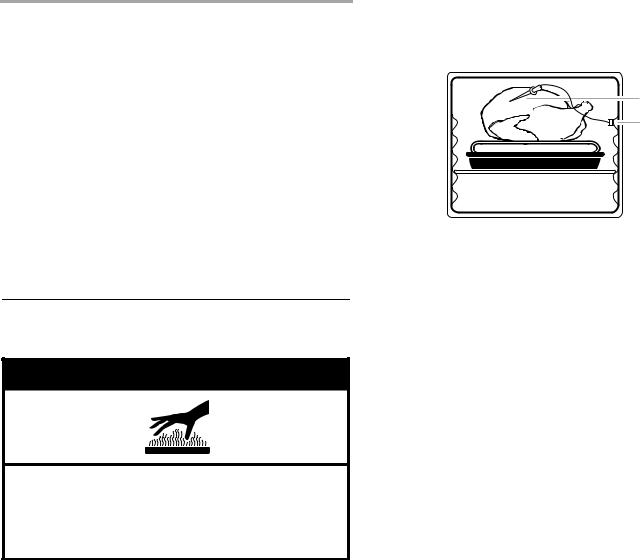
5.Press WARM DRAWER when finished.
6.Remove food from the drawer.
SETTING |
|
TYPE OF FOOD |
||
High |
■ |
Bacon |
■ |
Hamburger patties |
|
■ |
Beef - rare |
■ |
Hors d’oeuvres |
|
■ |
Casseroles |
■ |
Lamb |
|
■ |
Cooked cereals |
■ |
Pancakes |
|
■ |
Dinner plate |
■ |
Pizza |
|
■ |
Enchiladas |
■ |
Pork |
|
■ |
Eggs |
■ |
Potatoes - baked |
■Fish/seafood ■ Potatoes - mashed
|
■ |
Gravy, cream |
■ |
Poultry |
|
|
sauces |
■ |
Vegetables |
|
|
Ham |
||
|
■ |
■ |
Waffles |
|
|
|
|
||
|
|
|
|
|
Low |
■ |
Biscuits |
■ |
Pies |
|
■ |
Coffee Cake |
■ |
Warming - plates |
Meat Probe
(on convection models)
 WARNING
WARNING
Burn Hazard
Use an oven mitt to remove temperature probe. Do not touch broil element.
Failure to follow these instructions can result in burns.
The meat probe accurately measures the internal temperature of meat, poultry and casseroles with liquid and should be used in determining the doneness of meat and poultry. It should not be used during full and center broiling, convection broiling, dehydrating or proofing bread.
Always unplug and remove the meat probe from the oven when removing food.
To Use:
Before using, insert the probe into the center of the thickest portion of meat or into the inner thigh or breast of poultry, away from fat or bone at an angle as shown in following diagram. Place food in oven. Using the handle of the probe, connect the meat probe to the jack. Keep probe as far away from heat source as possible. Close oven door.
A
B
A.Meat probe
B.Meat probe jack
1.Press MORE OPTIONS.
2.Use the right Quickset pad to scroll to MEAT PROBE.
3.Select MEAT PROBE using the left Quickset pad.
4.Set the desired internal food temperature by selecting one of the displayed temperatures or use the number pads to enter the temperature. The probe temperature can be set between 100°F and 185°F (38°C and 85°C).
If the meat probe is not inserted, INSERT PROBE will be displayed.
5.Select BAKE or CONVECT.
6.If CONVECT was selected, select CNVT BAKE, CNVT ROAST or CNVT PASTRY.
7.Set the oven temperature by selecting one of the displayed temperatures or use the number pads to enter the temperature.
The display will briefly show the selected temperatures for the oven and probe.
After 10 seconds, the display will show the actual oven temperature and actual probe temperature
IMPORTANT: If the probe is removed from the oven receptacle at any time during the cooking process, the control will prompt INSERT PROBE. If the probe is not reinserted within 30 seconds, the program will be canceled and the oven will turn off.
8.When the selected internal temperature of the food has been reached, the oven will shut off and a “PROBE END” appears on the display.
NOTE: To avoid overcooking the food, remove it from the oven as soon as the oven shuts off.
9.Using the handle of the probe, remove the probe from the jack. The probe will be hot. Hold probe with an oven mitt or potholder when removing from the oven.
To Change Probe Temperature, Oven Setting:
Press CANCEL, then repeat previous steps.
After cooking, unplug the probe and remove food from oven.
See “General Cleaning” section to clean probe.
19

Drying(on some models)
For best results, use a drying rack. A drying rack allows air to circulate evenly around the food. If you would like to purchase a drying rack, one may be ordered. See “Assistance or Service” section to order. Ask for Part Number DRYINGRACK.
The convection fan will operate during the drying procedure.
To Set Drying:
1.Open the oven door slightly. The oven door needs to be opened slightly to allow moisture to escape from the oven during the drying process.
2.Place the magnetic door spacer Part Number 8010P146-60 over the plunger switch. The spacer provides a gap between the oven frame and the oven door to allow moisture to escape.
A 
3.Gently close the door until the spacer magnet makes contact with the oven door. The magnet will hold the spacer in the proper position during the drying process and allows the door to be opened at any time during drying without losing proper positioning.
IMPORTANT: If the spacer is not placed correctly, the convection fan will not operate.
4.Press CONVECT.
5.Use the right Quickset pad to scroll to DRYING.
6.Select DRYING using the left Quickset pad.
7.Use the Quickset pads to select a displayed temperature or enter a temperature with the number pads. Temperatures can be set between 100°F and 200°F (38°C and 93°C).
8.“DRYING” and the temperature will be displayed. “PREHEAT” will be displayed until the programmed temperature is reached.
9.Press CANCEL when finished drying.
Follow the Drying Guide chart for drying times.
Check foods at minimum times given. Cool foods to room temperature before testing for doneness.
A. Magnetic door spacer
DRYING GUIDE CHART
■The length of drying times vary due to water and sugar content of food, size of food pieces, amount of food being dried, humidity in the air.
■Check foods at the minimum drying time. Dry longer if necessary.
■Fruits that turn brown when exposed to air should be treated with an antioxidant. Try one of the following methods:
1.Dip fruit in a mixture of 3 tablespoons (44.4 mL) lemon juice to 1 qt (0.95 L) of cool water.
2.Soak fruit in a solution of 1 teaspoon (4.9 mL) ascorbic acid or commercial antioxidant to 1 qt (0.95 L) of cold water.
■Most fruits and vegetables dry well and retain their color when dried at 140°F (60°C). Meat and jerky should be dried between 145°F and 150°F (63°C and 65°C). For optimal flavor, dry herbs at 100°F (38°C), however, at this lower temperature expect extended drying times of up to 8 hours.
■Foods may drip during the drying process. After drying high acid or sugary foods, clean the oven bottom with soap and water. The porcelain oven finish may discolor if acidic or sugary food soils are not wiped up prior to high heat or a self-cleaning cycle.
■More than one rack of food may be dried at the same time. However, additional drying time is needed.
■Refer to other resources at your local library or call your local agricultural department service for additional information
FOOD |
VARIETIES BEST FOR |
PREPARATION |
APPROX. DRY |
TEST FOR DONENESS |
|
DRYING |
|
TIME AT 140°F |
AT MINIMUM DRY TIME |
|
|
|
(60°C) [HOURS]** |
|
|
|
|
|
|
FRUIT |
|
|
|
|
|
|
|
|
|
Apples* |
Firm varieties: Graven Stein, |
Wash, peel if desired, core and slice |
4 to 8 |
Pliable to crisp. Dried |
|
Granny Smith, Jonathan, |
into ¹⁄" (3.0 mm) slices. |
|
apples store best when |
|
Winesap, Rome Beauty, |
|
|
slightly crisp. |
|
Newton |
|
|
|
|
|
|
|
|
Apricots* |
Blenheim/Royal most |
Wash, halve, and remove pits. |
18 to 24 |
Soft and pliable |
|
common. Tilton also good. |
|
|
|
|
|
|
|
|
Bananas* |
Firm varieties |
Peel and cut into ¼" (6.0 mm) slices. |
17 to 24 |
Pliable to crisp |
|
|
|
|
|
Cherries |
Lambert, Royal Ann, |
Wash and remove stems. Halve and |
18 to 24 |
Pliable and leathery |
|
Napoleon, Van or Bing |
remove pits. |
|
|
|
|
|
|
|
Nectarines and |
Freestone varieties. |
Halve and remove pits. Peeling is |
24 to 36 |
Pliable and leathery |
Peaches* |
|
optional but results in better-looking |
|
|
|
|
dried fruit. |
|
|
|
|
|
|
|
Pears* |
Bartlett |
Peel, halve and core. |
24 to 36 |
Soft and pliable |
20
